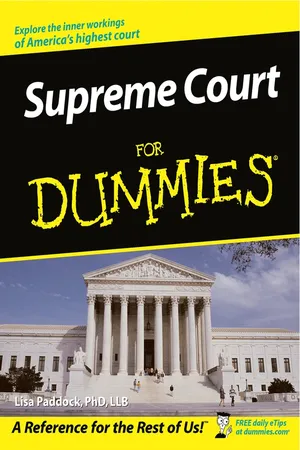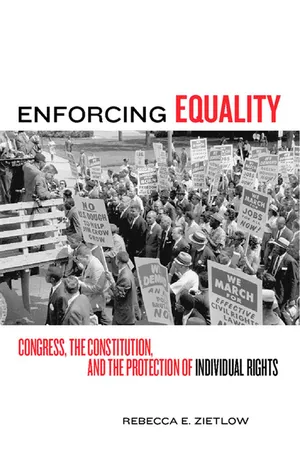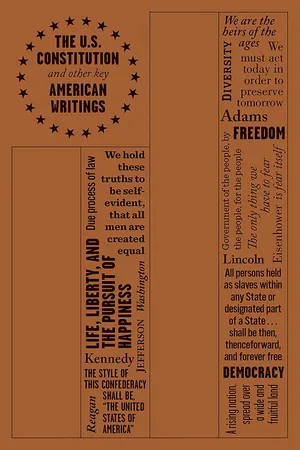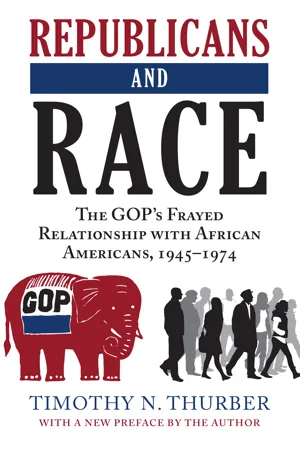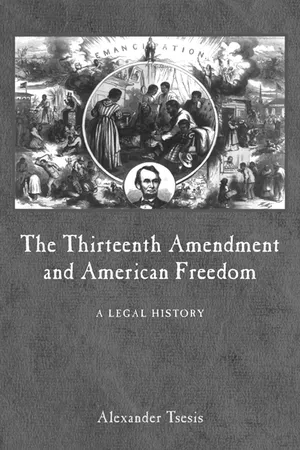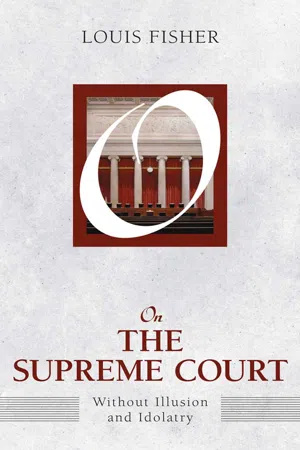History
Civil Rights Acts of 1866
The Civil Rights Act of 1866 was the first federal law to define citizenship and affirm that all citizens were equally protected by the law. It granted citizenship and the same rights to all people born in the United States, regardless of race or previous condition of servitude. The act aimed to counter the discriminatory Black Codes and lay the groundwork for future civil rights legislation.
Written by Perlego with AI-assistance
Related key terms
7 Key excerpts on "Civil Rights Acts of 1866"
- eBook - ePub
- Lisa Paddock(Author)
- 2011(Publication Date)
- For Dummies(Publisher)
During the 1860s when the Civil War Amendments were adopted, Congress differentiated between civil, political, and social rights. The Thirteenth and Fourteenth Amendments were meant to address civil rights, giving African-Americans equality in the legal workings of the public and private realms by bestowing on them the right to own property, the right to enter into contracts, the right to appear as a witness in court, and so on. The Fifteenth Amendment, in granting blacks the voting franchise, more or less took care of political rights. Social rights, however, were still unsettled, and in 1875, Congress attempted to address them with another Civil Rights Act.The Civil Rights Act of 1875 was in essence a desegregation law. It granted African-Americans the right to sit on juries and the right to mingle with white society in public accommodations such as inns, theaters, and public transportation. Any attempt to violate these rights was subject to federal jurisdiction and ultimately to review at the U.S. Supreme Court. The act was the legacy of Senator Charles Sumner, Republican of Massachusetts, who did not live to see either the act’s passage or its evisceration. The Civil Rights Act of 1875 was nearly a century ahead of its time.In one of the earliest cases to test the Civil Rights Act of 1875, Strauder v. Virginia (1880), the Supreme Court held that a state law excluding blacks from juries was a violation of the Fourteenth Amendment’s Equal Protection Clause. Three years later, however, the Court gutted the legislation in the Civil Rights Cases. The Civil Rights Cases - eBook - ePub
Enforcing Equality
Congress, the Constitution, and the Protection of Individual Rights
- Rebecca E Zietlow(Author)
- 2006(Publication Date)
- NYU Press(Publisher)
Most significantly, one year later, Congress enacted the Voting Rights Act of 1965, which gave teeth to the Fifteenth Amendment’s prohibition of race-based denials of the franchise. Like the 1964 act, the voting rights bill also responded to the demands of civil rights activists, for whom registration of black southern voters was a top priority. 199 The Voting Rights Act was arguably even more significant than the 1964 Civil Rights Act because federal enforcement enabled blacks to vote throughout the south, finally allowing them to engage in the mainstream political process. 200 As southern blacks started to vote, they encouraged Congress to continue to act to enforce equality norms throughout the following decade. By the mid 1970s, Congress had adopted the most far-reaching measures to protect rights of belonging in our history. Other legislation prohibiting discrimination on the basis of race includes the Fair Housing Act, which prohibits race discrimination in real estate transactions, 201 and the Equal Credit Opportunity Act of 1974. 202 In the late 1960s, the women’s rights movement gained momentum, and Congress responded by enacting multiple pieces of legislation prohibiting discrimination on the basis of gender, including Title IX of the Education Amendments of 1972 and the Pregnancy Discrimination Act of 1998. 203 During this period, Congress expanded the classifications of people whose rights were entitled to protection, prohibiting discrimination against the disabled 204 and the elderly, 205 and requiring that public education be accessible to disabled children. 206 Congress was not solely concerned with antidiscrimination law during this era - Founding Fathers(Author)
- 2015(Publication Date)
- Canterbury Classics(Publisher)
THE CIVIL RIGHTS ACT (1964) __________ In June 1963, President John F. Kennedy proposed that the United States adopt a sweeping civil rights law that would prohibit segregation in all public places and of all public facilities, would prohibit restrictions to voting rights, and would prohibit employment discrimination based on race, color, sex, religion, or national origin. After Kennedy’s assassination in 1963, President Lyndon B. Johnson continued to fight for the legislation. He faced much opposition in Congress, including a Senate filibuster, but the Civil Rights Act finally became law on July 2, 1964. A n act To enforce the constitutional right to vote, to confer jurisdiction upon the district courts of the United States to provide injunctive relief against discrimination in public accommodations, to authorize the Attorney General to institute suits to protect constitutional rights in public facilities and public education, to extend the Commission on Civil Rights, to prevent discrimination in federally assisted programs, to establish a Commission on Equal Employment Opportunity, and for other purposes. Be it enacted by the Senate and House of Representatives of the United States of America in Congress assembled, That this Act may be cited as the “Civil Rights Act of 1964”. T ITLE I V OTING R IGHTS S EC. 101. Section 2004 of the Revised Statutes (42 U.S.C. 1971), as amended by section 131 of the Civil Rights Act of 1957 (71 Stat. 637), and as further amended by section 601 of the Civil Rights Act of 1960 (74 Stat- eBook - ePub
Republicans and Race
The GOP's Frayed Relationship with African Americans, 1945-1974
- Timothy N. Thurber(Author)
- 2014(Publication Date)
- University Press of Kansas(Publisher)
“There is an inexorable moral force that moves us forward,” Dirksen proclaimed. “No matter what the resistance of people who do not fully understand, it will not be denied. Utter all the extreme opinion that you will,” he said; then, extending his right arm toward Goldwater, added, “it will not be denied.” The bill passed 73–27. Twenty-seven Republicans voted for it, with just six opposed. The House easily approved the Senate measure on July 2. Johnson signed it into law that night in a televised ceremony at the White House. 37 Civil rights leaders were elated. Farmer declared that the legislation “may well be the single most important act of our Congress in several decades.” Wilkins described it as “a giant step forward,” while King predicted it would “bring a cool and serene breeze to an already hot summer.” 38 Conclusion The 1964 Civil Rights Act constituted an important milestone in the African American freedom struggle. Legally enforced segregation of public accommodations in the South crumbled quickly. The demise of Jim Crow represented much more than blacks and whites being able to sit in the same section of a restaurant; it marked the collapse of one of the psychological foundations of southern race relations. As King had stated in his “Letter from Birmingham Jail,” blacks were “humiliated day in and day out by nagging signs reading ‘white’ and ‘colored.’” Change was not an inevitable result of industrialization, urbanization, or other abstract social forces; it required firm steps by federal authorities. 39 Title VII, which forbade employment discrimination based on race, color, gender, national origin, and religion, was another turning point. Some economists have argued that Title VII’s effect on those it was intended to help has been minimal; according to others, it has been counterproductive. There is some truth in both these claims. Yet its impact has been far more beneficial than critics acknowledge - Kasper Lippert-Rasmussen(Author)
- 2017(Publication Date)
- Routledge(Publisher)
In defending Section 1, the Fourteenth Amendment’s proponents expressed the need to protect the freedmen by putting a check on the power of states. The equality proposed in that section was explicitly comparative. Like God instructing Moses on sacrifices, the Fourteenth Amendment (according to its proponents) instructed the states:Whatever law punishes a white man for a crime shall punish the black man precisely in the same way and to the same degree. Whatever law protects the white man shall afford “equal” protection to the black man. Whatever means of redress is afforded to one shall be afforded to all. Whatever law allows the white man to testify in court shall allow the man of color to do the same.(Congressional Globe 1866: 2459)This instruction was necessitated by the immediate post-war condition in the South, where, asserted one defender of the Amendment,color disqualifies a man from testifying in courts, or being tried in the same way as white men. I need not enumerate these partial and oppressive laws. Unless the Constitution should restrain them, those States will all, I fear, keep up this discrimination, and crush to death the hated freedmen.(Congressional Globe 1866: 2459)President Andrew Johnson, who succeeded to the office after Lincoln’s assassination, assumed a substantial place in the Congressional debates, excoriated by Republicans and defended by Democrats. The sources of Republican ire? Johnson had given a blanket pardon to former Confederates, allowed the rebel states to reconstitute themselves, vetoed the Second Freedmen’s Bureau Act in early 1866, and vetoed the Civil Rights Act of 1866. The latter veto was overridden immediately by Congress and the Civil Rights Act became law. Indeed, it was because the Republicans so strongly valued the rights this law extended to the former slaves that they acted by means of the Fourteenth Amendment to entrench them, in a general way, in the Constitution, where they could not be swept away in the future by a simple majority vote in Congress.As soon as Congress completed work on the Fourteenth Amendment, it repassed the Second Freedmen’s Bureau Act. Johnson again vetoed it and this time Congress overrode the President’s veto. The Freedmen’s Bureau, created in the War Department in 1865 to bring relief to the newly freed slaves while war was still raging, was authorized among other things to distribute abandoned or expropriated lands to the freedmen and assist them in becoming self-sufficient. The Second Freedman’s Bureau Act extended this authorization and, in addition, gave the Bureau Commissioners power to protect a panoply of civil rights belonging to the freedmen. President Johnson had many objections to the new bill but one feature prompted him to complain of what we would now call “reverse discrimination” and “affirmative action.” He wrote:- eBook - ePub
The Thirteenth Amendment and American Freedom
A Legal History
- Alexander Tsesis(Author)
- 2004(Publication Date)
- NYU Press(Publisher)
Reflecting on the debates with a critical eye, however, is not meant to be a condemnation of the framers’ motives. Radicals persistently evinced their commitment to protecting all citizens’ fundamental liberties. Initially, the executive and the judiciary stood in the way of Radical Reconstruction. In 1866, Congressman Isaac Arnold, a veteran Radical Republican, laid out the military and political steps that led up to the Thirteenth Amendment:First , The army was prohibited from returning to rebel masters, fugitive slaves: Second , The employment of fugitive slaves as laborers in the army was sanctioned: Third , The passage of a law confiscating and conferring freedom upon slaves used for insurrectionary purposes: Fourth , The abolition of slavery at the National Capital: Fifth , The prohibition of slavery in all the territories: Sixth , A law giving freedom to all who should serve as soldiers in the army or in the navy: Seventh , A law emancipating the slaves of rebels: Eighth , And most important of all, the great Proclamation of Emancipation; emancipating the slaves in the rebellious States: Ninth , A law emancipation of the families of all those who should serve in the army or navy of the United States: Tenth , The repeal of the fugitive slave code: Eleventh , The Constitutional amendment abolishing and prohibiting slavery throughout the Republic.Eventually two more Reconstruction amendments followed, but the congressional framers initially considered the Thirteenth Amendment as the bedrock of Reconstruction.2Laws, such as the Civil Rights Act of 1866 and the Freedmen’s Bureau Acts, which passed soon after the ratification of the amendment, began giving content to the liberties the framers expected to protect. These laws were rooted in an ideal of liberty that grants all citizens the same rights to make meaningful decisions about their lives and to obtain judicial redress for coercive infringements to their autonomy. The statutes’ provisions made federal authorities responsible for preventing public and private injustices in the areas of property transaction, contract enforcement, and litigation. Radical Republicans envisioned a sweeping reconstruction that would cover discrimination committed in the North and South. In the minds of progressive humanists, this was only to be the start of abolition, encompassing all institutions associated with slavery and heralding in constitutionally guaranteed freedom, the likes of which had never existed in the United States. Those hopes were never realized: they were swept away by popular prejudices, in both regions of the country.3 - eBook - ePub
On the Supreme Court
Without Illusion and Idolatry
- Louis Fisher(Author)
- 2016(Publication Date)
- Routledge(Publisher)
HAPTER FIVE INDIVIDUAL AND MINORITY RIGHTSSeveral decisions by the Supreme Court after the Civil War damaged the Court’s reputation as guardian of individual and private rights. Citizens sought protection from the courts only to lose on a regular basis. Gradually they learned their interests were better defended by legislative bodies at the state and national levels. When Congress passed legislation in 1875 to provide blacks with equal access to public accommodations, the Supreme Court declared the legislation unconstitutional. Women who wanted to practice law found that the legislative branch, not the courts, would protect their interests. In 1896, the Court granted its blessing to a “separate but equal” statute passed in Louisiana to require blacks and whites to sit separately in railroad cars. These judicial errors survived until the 1950s and 1960s, when they were finally reversed by the Court’s desegregation decision in 1954 and the Civil Rights Act of 1964. Congress has frequently been a better defender of religious liberty than the courts.Protecting the Rights of Women
After the Civil War, women began to attend medical and law schools and pursue other professional opportunities formerly dominated by men. They found legal support from legislative bodies, but not from courts. The theory of British legal scholar William Blackstone, writing in the late 1700s, placed women in a subordinate status. He wrote about the doctrine of “coverture,” which in marriage made husband and wife “one person in law: that is, the very being or legal existence of the woman is suspended during the marriage, or at least is incorporated and consolidated into that of the husband: under whose wing, protection, and cover , she performs every thing.”1 Although some women did not marry and should not have been subjected to his doctrine, courts treated unmarried women as the exception, not the rule.After studying law, Myra Bradwell applied for admission to the Illinois bar in 1869. She needed the approval of an all-male panel of judges to practice in Illinois. They rejected her application solely on the ground that she was a woman. Her appeal to the Supreme Court of Illinois failed.2 Of her qualifications the court said: “We have no doubt.”3 British law and custom weighed heavily in the court’s analysis, however. Female attorneys “were unknown in England, and a proposition that a woman should enter the courts of Westminster Hall in that capacity, or as a barrister, would have created hardly less astonishment than one that she should ascend the bench of Bishops, or be elected to a seat in the House of Commons.”4
Learn about this page
Index pages curate the most relevant extracts from our library of academic textbooks. They’ve been created using an in-house natural language model (NLM), each adding context and meaning to key research topics.
